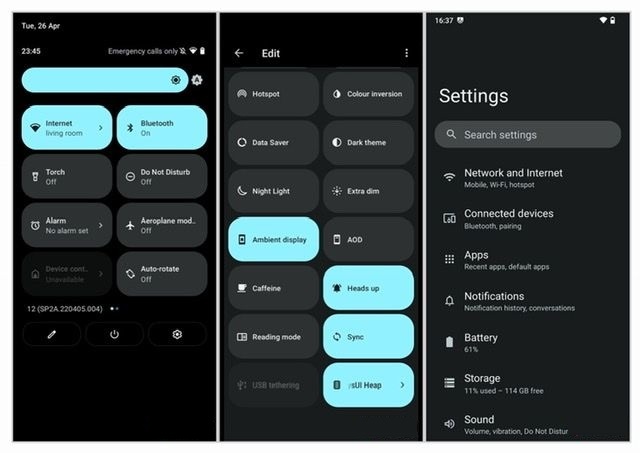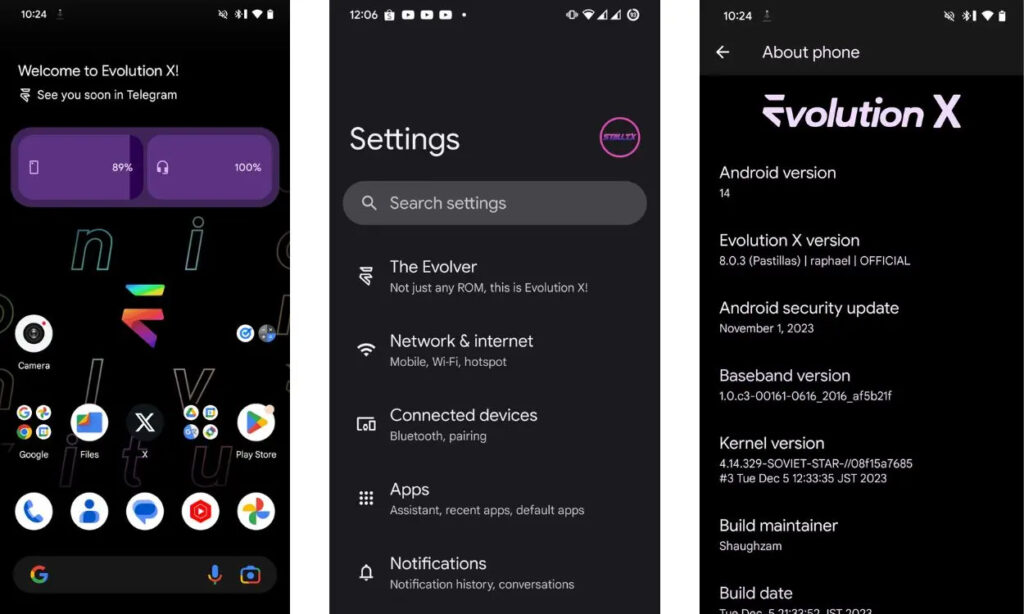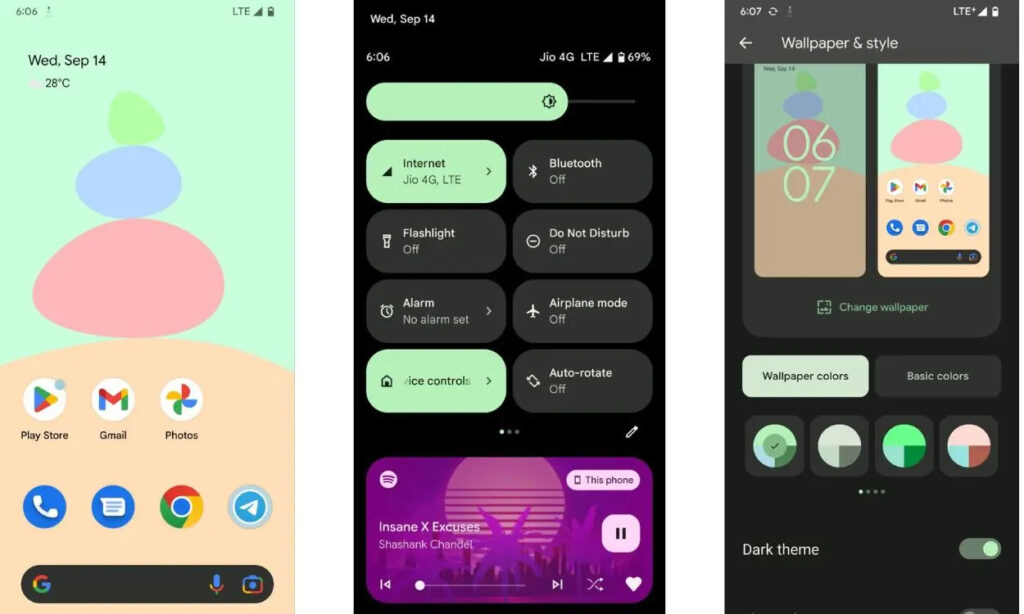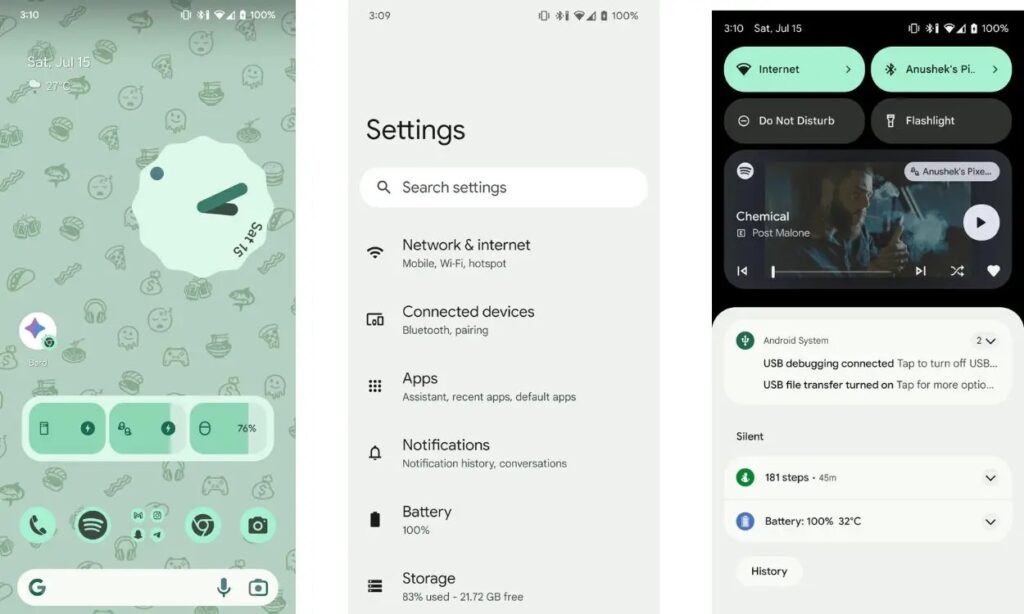
The Android developer community is vast, showcasing its remarkable capability in creating custom ROMs or personalized Android builds. A custom ROM refers to an aftermarket firmware development derived from the Android source code offered by Google. If you’re in search of a suitable custom ROM for your device and find yourself uncertain about which one to choose, we’ve compiled a list of the 12 best custom ROMs for Android in 2024.
1. Pixel Experience
Pixel Experience stands out as the premier custom ROM for Android at present, owing to several compelling reasons. Firstly, its extensive device support ensures compatibility with a wide range of smartphones. Secondly, it brings Pixel features to non-Pixel devices, accompanied by built-in support for Google Camera (GCam) and a host of additional features.
Third, the ROM excels in overall stability, surpassing other ROMs tested over the years. Notably, the primary developer, Henrique Pereira, prioritizes stability over hasty porting of new Android versions to all devices.

Instead, the developer strategically selects a widely-used and developer-friendly device to establish a solid foundation. Subsequently, all modifications are shared on GitHub for collaboration with other maintainers. Noteworthy is the global network of Pixel Experience maintainers who diligently address bugs around the clock.
In essence, if you prioritize both stability and access to the latest features inspired by Pixel devices, Pixel Experience stands out as the unrivaled choice for a custom ROM on Android. It’s important to note that while immediate access to the latest Android build may not be guaranteed, a stable and trouble-free experience is assured.
2. LineageOS
When the term “custom ROM” is mentioned, LineageOS often springs to mind. Initially CyanogenMod, it took over the legacy after Cyanogen’s discontinuation in the fall of 2016, when the developer community revived the project under the name LineageOS.

Derived from Google’s AOSP code with substantial enhancements, LineageOS functions both as an independent ROM and a foundation for various other custom ROMs. Boasting the largest developer team, it officially supports over 190 devices. The ROM offers fundamental yet practical features, such as customizable status bars, theme adjustments, navbar edits, and more.
While LineageOS is considered relatively straightforward, its stability is a standout feature. Many users treat it as a versatile canvas onto which they can apply various themes and feature modifications. Notably, LineageOS excels in providing robust privacy and security within the realm of custom ROMs. Additionally, the development team has been swift in adopting Android 14, making it available for numerous devices.
3. Paranoid Android
Recently, the beloved custom ROM Paranoid Android made a remarkable comeback. Recognized as one of the most revered custom ROMs in history, Paranoid Android has initiated the release of its first batch of Android 14 Beta builds. The ROM focuses on delivering a refined and polished user experience, emphasizing simplicity that may not cater to everyone but assures a seamless user journey.

Among its noteworthy features are a redesigned quick settings menu, support for gestures, and a set of handy options tailored for power users. Paranoid Android achieved a significant milestone when Google incorporated its then-known ambient mode, “Peek,” into AOSP, showcasing the team’s prowess. So, the next time you engage with Ambient Display, it’s worth recalling the contribution of Paranoid Android.
While Paranoid Android boasts compatibility with a wide array of devices, updates for most versions have not been rolled out since July 2023. Despite ongoing development for numerous Xiaomi phones, new ROMs are primarily targeted at relatively modern devices. The latest Paranoid Android iteration, named Uvite, is based on Android 14 and is currently available for select Android devices.
4. GrapheneOS
GrapheneOS and CalyxOS share similar objectives, aiming to safeguard user privacy by restricting Google’s tracking of location and data. However, the notable distinction lies in their approaches to running Google apps.

GrapheneOS adopts a strategy known as Sandboxing, which, in simpler terms, involves emulation and the execution of apps within an isolated environment rather than directly on the device. This method enhances privacy and security by creating a barrier between the apps and the device itself.
Much like CalyxOS, GrapheneOS is exclusively designed for Pixel devices. It closely aligns with the Android Open Source Project (AOSP) and deliberately limits customization features. It caters primarily to individuals seeking to distance themselves from Google’s influence, offering a privacy-focused alternative.
5. Evolution X
Evolution X emerges as a modern iteration of the Resurrection Remix from the past, renowned for its extensive customization features coupled with relative stability. The ROM achieves this by amalgamating diverse code snippets into a unified project, providing a broad spectrum of features across multiple devices. Despite a slightly slower update pace due to this comprehensive approach, Evolution X ensures regular updates to its users.

In contrast to Paranoid Android, which is just commencing Android 14 builds, Evolution X has already made Android 14 available for numerous both old and contemporary devices. Going beyond the typical realm of customization, Evolution X distinguishes itself by offering an impressive array of options. Users have the ability to personalize minutiae ranging from the status bar to the home screen, making it one of the most customizable AOSP ROMs in its class.
6. Project Elixir
For those in search of the finest Android 14 custom ROM, look no further than Project Elixir. This AOSP ROM seamlessly blends the familiarity of stock Android with Pixel features and an extensive range of customization options. Notably, it introduces Essense, a feature based on the Substratum theme, enhancing the lock screen experience with a touch of elegance that sets it apart from other ROMs.

What sets Project Elixir apart is its commitment to regular updates and the diligent resolution of bugs. In terms of device support, the ROM covers a wide spectrum, including devices from Xiaomi, OnePlus, Nokia, and Nothing. With its compatibility across various OEMs, Project Elixir stands out as one of the premier Android 14 custom ROMs currently available, offering an experience that shouldn’t be overlooked.
7. PixelOS
PixelOS presents a distinct take on stock Android, aiming to deliver a Pixel-like user interface enriched with enhancements, improvements, and enhanced stability. Striking a balance between features and simplicity, PixelOS avoids overwhelming users with an excess of options and prioritizes essential utilities. Built on the stability of AOSP, the ROM is known for its reliability, and developers have begun rolling out Android 14 updates.

PixelOS caters to a broad range of devices, including those from Realme, Samsung, Motorola, OnePlus, Asus, and more. The development team remains proactive, consistently releasing new builds that incorporate features and security patches. In terms of design, PixelOS impresses with its simplicity and aesthetics. For those eager to explore Android 14, PixelOS stands as a noteworthy option, sharing similarities with PixelPlusUI and PixysOS while offering its own unique feature set.
8. crDroid
Picture yourself on your device’s stock ROM, but with subtle tweaks that allow for customization without sacrificing the stability inherent in stock Android. That’s precisely what crDroid offers. With a notable presence in the realm of stock Android enthusiasts, crDroid has garnered substantial popularity. Similar to AOSP Extended, it boasts an active development team and extends support to a wide range of older devices.

This ROM provides the authentic AOSP experience akin to Google’s lineup, complemented by rigorously tested features. Leveraging its foundation on LineageOS, crDroid showcases exceptional performance and impressive battery life. In essence, envision LineageOS enriched with additional features and tweaks. The extensive list of supported devices encompasses both contemporary and older models, making crDroid an appealing choice for users seeking a balance between stock stability and customization.
9. Havoc OS
Describing Havoc-OS goes beyond a brief summary. Initially, it may appear akin to many other custom ROMs, but the true essence of Havoc-OS reveals itself after a few days of usage. Pioneering the implementation of an extensive array of features, Havoc-OS harkens back to the days of ROMs like Resurrection Remix and Paranoid Android.

Havoc-OS distinguishes itself with a wealth of added functionalities, offering numerous modifications for the status bar, buttons, lights, gestures, and various other configurations. While occasional stability issues may arise, it undeniably stands out for having the maximum level of customizability features. For those seeking an experience reminiscent of Resurrection Remix but with the latest Android version, Havoc-OS provides a homecoming of sorts.
10. Bliss ROM
Bliss ROM, a relatively new entrant in the Android ecosystem, shows immense potential by extending its development not only to smartphones but also to tablets and Windows devices like the Surface Pro. It offers a unique and pleasant experience, featuring a customized launcher and a desktop mode.

While the unconventional system navigation might not appeal to all users, it underscores the importance of diverse skins in reshaping the boundaries of user interface design within custom ROMs. Bliss ROM, in addition to introducing tweaks for customizability and functionality, places a significant emphasis on enhancing the visual aesthetics of your device.
With its dedicated settings panel called Blissify, users can modify a wide range of elements, including themes, animations, and the lock screen interface. If you’re open to trying something different and innovative, Bliss ROM is certainly worth a shot for a distinctive and refreshing Android experience.
11. OmniROM
OmniROM stands as one of the oldest custom ROMs on this list, with its inception dating back to 2013 during the peak popularity of CyanogenMod. Over the years, OmniROM has persisted in delivering clean, AOSP-based ROMs characterized by rock-solid stability and extensive device support.

Despite not venturing into radical changes, OmniROM has maintained a commitment to providing a reliable and consistent experience. The project has extended its efforts to Android 14, releasing updates for a variety of devices such as the ROG Phone, Google Pixel, Redmi Note series, and more. While not the fastest in terms of updates, OmniROM strikes a balance, offering good performance for day-to-day tasks and ensuring a stable and dependable custom ROM experience.
12. Xiaomi.eu
Dealing with the inherent bloat and resource-heavy nature of MIUI can be a concern for many users. Fortunately, the Xiaomi.eu project provides a solution by offering a custom ROM based on pure MIUI, devoid of any bloatware, ads, or resource-intensive background processes.

For enthusiasts who appreciate MIUI but wish to steer clear of the AOSP route, Xiaomi.eu ROM stands out as one of the best options for Xiaomi phones. Releasing weekly builds for testers and stable releases for general users, this ROM caters to a variety of preferences. Notably, it has extended support for the latest Xiaomi HyperOS based on Android 14. If you own a Xiaomi device, the Xiaomi.eu ROM is a compelling choice, ensuring a streamlined MIUI experience without the unnecessary bloat.
Why You Need To Install a Custom ROM?
The primary motivation for many users to opt for custom ROMs stems from the disappointment of manufacturers discontinuing software support for phones 2-3 years after their launch. The frustration of witnessing other devices receive new features while struggling with a lack of updates prompts users to turn to custom ROMs. These ROMs provide a lifeline for older devices, keeping them alive and updated with the latest versions of Android.
Beyond the longevity factor, another compelling reason for the popularity of custom ROMs is the extensive modding possibilities they offer. Free from bloatware, these ROMs come loaded with default customization features, providing users with endless possibilities to personalize their devices. However, it’s essential to note that not all custom ROMs are equally stable, and finding one that is reliable enough for daily use requires careful consideration.
To install a custom ROM, you need to unlock the bootloader and install a custom recovery like TWRP. Before starting, it’s advisable to create a backup of your Android device. Additionally, since not all ROMs come with Google Apps pre-installed, you may have to flash a GApps package such as OpenGapps (website) or NikGApps (website). Our Android team at AzMo Tech has extensively tested the ROMs listed below on various devices, providing an unbiased compilation of the best custom ROMs for you to try in 2024.
Custom ROMs offer a fresh experience for both old and new mobile devices. While no ROM can match the stability of the stock ROM, opting for a custom ROM allows you to trade a bit of stability for numerous features. Having tested custom ROMs for many years, users often explore different options in the quest to find the best one. What’s your preferred custom ROM? Let us know in the comments section below.


